pectus excavatum baby symptoms
Not all cases need surgery. Cartilage is what makes up the outer portion of the ear and lines the joints of the body.

Full Shot And Limbs At The Age Of 9 Years A Evidence Of Pectus Download Scientific Diagram
The symptoms can be both physical and psychological.

. Pectus excavatum is a congenital deformity of the chest wall that causes several ribs and the breastbone sternum to grow in an inward direction. Her pregnancy was complicated by placenta previa and severe anemia but she delivered a healthy baby. While this can be noted early in life pediatric pectus excavatum often worsens during a growth spurt in adolescence.
Pectus excavatum PECK-tuss ex-kuh-VAW-tum is a condition that causes a childs chest to look sunken or caved in It happens because of a defect in the tough connective tissue cartilage that holds the bony part of the ribs to the breastbone. The depression in the chest is due to abnormal growth of the cartilage that attaches the sternum to the ribs. Due to the pectus patients may have less space in the chest which can limit heart and lung function.
Because of the deep depression the lower ribs can stick out and give the appearance of a potbelly in younger children. It is believed to be a disorder of the cartilage that joins the ribs to the breastbone. Pectus excavatum is a chest deformity where the breastbone sternum appears sunken.
Pectus excavatum affects about one in. The cartilage pushes the breastbone sternum inward. Pectus excavatum also known as concave chest or funnel chest is a deformity of your childs chest wall.
This is sometimes called sunken or funnel chest. This may cause a child concern. In pectus excavatum the cartilage is extra long and pushes the.
The severity of this condition can range from mild to severe. The condition is not always noticeable at birth but is often apparent by the time a child is 2 to 3. With pectus excavatum the sternum goes inward to form a depression in the chest.
Diagnosis and treatment are discussed. Both or just one side of the breastbone may be affected. What is a pectus excavatum.
While most patients do not have symptoms those with severe. Pectus excavatum a deformity of the sternum and ribs caused by an unbalanced costochondral hypertrophy is a congenital abnormality with a prevalence of 1 per 1000 patients. But there is an example of a woman who gets pregnant two years after pectus excavatum repair.
Other symptoms include flared shoulder blades and ribs along with a hunched posture. Amongst doctors dealing with pectus excavatum there is a lot of discussion. Children with mild pectus excavatum often have no other symptoms but more severe cases can affect the heart and lungs.
Pectus excavatum is a depression caused when the sternum breastbone is abnormally pushed inward. It can present in toddlers but typically becomes apparent during the growth spurt and puberty. Pectus excavatum is caused by the abnormal growth in the chest of the connective tissues cartilage that attach the breastbone sternum to the ribs.
Stay in Contact With Your Doctor. The condition is also called sunken. What Is Pectus Excavatum.
Usually the ribs and sternum go outward at the front of the chest. The breastbone or sternum and some of the ribs grow abnormally causing a depression in the middle of the chest. Shortness of breath with exercise.
This information from Great Ormond Street Hospital GOSH is about pectus excavatum also known as funnel chest. Pectus excavatum is clearly visible as a sunken portion in the center of a childs chest. Pectus carinatum is a childhood condition in which the sternum breastbone sticks out more than usual.
Pectus excavatum makes the chest look sunken. The way pectus excavatum affects pregnancy is by a mild form of dyspnea. The sunken chest can be fixed with surgeries like the Nuss procedure or Ravitch procedure.
Pectus excavatum is a condition in which instead of being level with the ribs the breastbone sternum is sunken so that the middle of the chest looks caved in. 1 2 Pectus excavatum may be associated with connective tissue disorders such as Marfan and. The cartilage turns to bone as the baby matures.
Usually the ribs and sternum go outward at the front of the chest. A doctor will perform a physical examination of the chest to see if it pushes inward. It occurs mostly in boys and frequently more members in a family are affected.
A person with pectus excavatum may have other symptoms such as. This causes a depression in the chest that can range from mild to severe. The most common chest wall deformity pectus excavatum or sunken chest is most likely caused by abnormal growth of the costal cartilage junction between the ribs and sternum.
Decreased stamina compared to peers. Supranuclear palsy also known as Progressive supranuclear palsy Supraventricular tachycardia. Physical symptoms can include.
Pectus Excavatum PE the most frequent congenital chest wall deformity is characterized by anomalous growth of several ribs and sternum which makes the chest hollow Figure 1PE occurs in 1 in 300-1000 live births with a malefemale ratio of approximately 41 with a tendency to become more evident during adolescence1-4 The causes. Pectus excavatum is a condition in which the breastbone is sunken into the chest.

Pectus Excavatum In Babies Kids 7 Tips For Parents
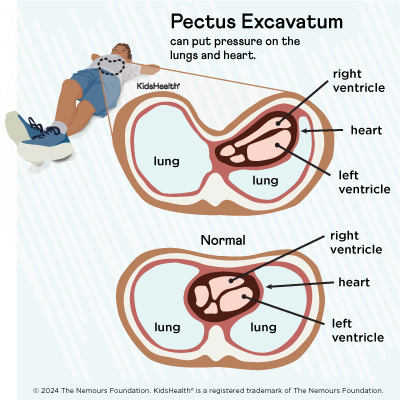
Chest Wall Disorder Pectus Excavatum For Parents Norton Children S

21 Pectus Stock Photos Pictures Royalty Free Images Istock

A Proband At 3 Years Of Age With Pectus Excavatum Relatively Short Download Scientific Diagram
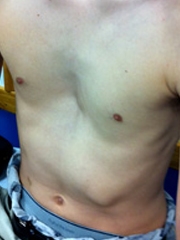
Pectus Excavatum Children S Hospital Of Philadelphia
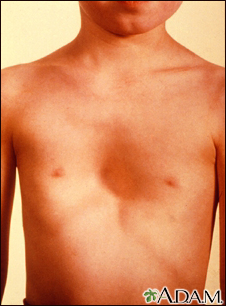
Pectus Excavatum Information Mount Sinai New York
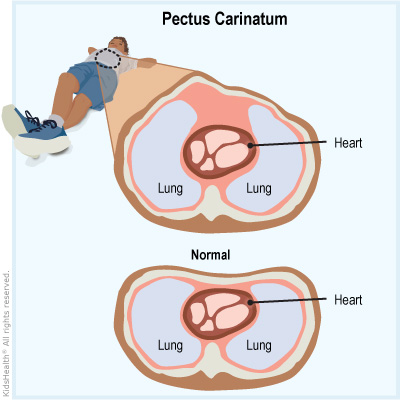
Chest Wall Disorder Pectus Carinatum For Parents Norton Children S

Pectus Excavatum From A Pediatric Surgeon S Perspective Semantic Scholar

Strength Training With Pectus Excavatum Wasserman Strength

Pdf Essentials Of Pediatric Surgery
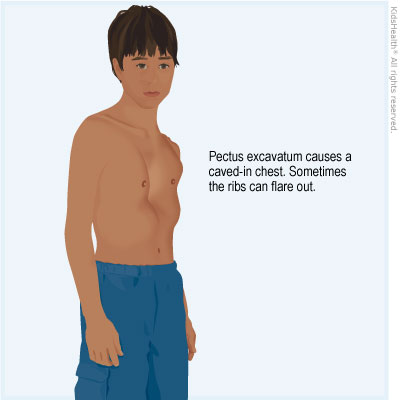
Chest Wall Disorder Pectus Excavatum For Parents Primary Children S Hospital

Pectus Excavatum Funnel Chest Asthma Lung Uk

Help My Baby S Chest Is Caving In Pectus Excavatum Dr Paul Youtube
Hie Multimedia Pectus Excavatum

Pectus Excavatum Overview Symptoms Treatments And More

Pectus Excavatum Symptoms Treatments And Complications

Pectus Excavatum And Improve Your Homoeopathic Knowledge Facebook
